DarpaGrandChallenge
Latest

DARPA's next challenge could lead to AI-powered radios
So far, the solutions to wireless spectrum crunches have involved either offering relatively untapped airwaves or reusing frequencies that were previously assigned to something else. However, DARPA knows this can't go on forever -- and it's looking for help to devise a clever way around the problem. The military research agency has launched a new Grand Challenge that will have teams develop artificial intelligence-powered radios that cooperate with each other to avoid wireless congestion. Rather than force devices to use narrow frequency ranges regardless of how crowded they may be, DARPA would like to see those gadgets negotiate frequency sharing whenever they need it.

DARPA's next Grand Challenge to focus on humanoid robots
DARPA's Grand Challenges have already helped put plenty of self-driving cars on (closed) roads, but it looks like the agency has something a bit different in mind for its next one. As first reported by Hizook, DARPA has apparently set its sights on humanoid robots as its next target -- specifically, robots that are human-like enough to navigate rough terrain, drive a vehicle and manipulate regular tools (the idea being to simulate assisting in an industrial disaster zone). What's more, participants will have to develop robots that can do all of that "semi-autonomously," with only "supervisory teleoperation" permitted. No word on a timeline for the challenge just yet, but DARPA will apparently have more to say when it makes things completely official within the next few weeks. [Thanks, Travis]

Self-driving "Marvin" SUV gets set for DARPA's Urban Challenge
It looks like DARPA's newly-instated Urban Challenge is shaping up nicely, with this self-driving Isuzu SUV from Austin Robot Technology and the University of Texas now joining the likes of Team LUX's Volkswagen Passat and NC State's Lotus Elise in competing for the top prize. As with those other vehicles, the SUV (dubbed Marvin) is completely autonomous, relying on an array of sensors, video cameras, artificial intelligence, and machine-learning technology to (hopefully) avoid catastrophe as it motors about. As you might guess, the Urban Challenge presents a few different obstacles for the vehicles to deal with than the Grand Challenge does, including intersections, improperly parked cars, and traffic laws that must be followed at all times. Marvin still has a ways to go before it can get a chance to drive away a few million dollars richer, however, with it required to pass a basic driving test this summer and a national qualifier in October before it's allowed to enter the big event in November.[Photo courtesy of Ralph Barrera/American-Statesman]

Google to license Stanford's Stanley tech, enhance maps
Although Google Maps might have been called out by name as the best in "Lazy Sunday" (double true), Microsoft's been gaining ground of late by adding lots of trick features to its own mapping site, particularly some nifty simulated 3D views. Well, Google is never one to lie back and take it from the Redmond crew, so it's struck a deal with Stanford to license the sensing technology behind 2005 DARPA Grand Challenge winner Stanley to improve their maps. Stanley, as you probably remember, was a robotic Volkswagen Touareg put together by the Stanford Racing Team that zipped across the Mojave Desert for 10 hours without any human input, winning the Grand Challenge by a hair. Now that same tech will reportedly be used to scan building faces and improve the 3D portions of Google Maps and Google Earth. Details of the deal and how it will be implemented are due to be announced during the Where 2.0 conference on May 29 and 30 -- here's hoping it involves the phrase "army of robotic Google cars." [Via I4U News]

Watch out Stanley, here comes Junior
With the slow vehicle passing and a 50mph speed limit, the 2005 DARPA Grand Challenge didn't entirely seem to set the stage technologically for the 2007 DARPA Urban Challenge, but get ready, Stanford's already prepping, their entrant: Junior. The Volkswagen Passat wagon will be equipped with a 360-degree laser rangefinder, bumper mounted lasers, RADAR, GPS, a network of systems and software powered by Core 2 Duo processors, and hopefully also spinners to distract the competition's junk-ass rides. Junior's mission, if you choose to recall it: drive a simulated urban course 60 miles long; it must obey California state traffic laws, it must not crash, it must be able to operate without GPS, and it must run the course entirely without human input. The $2m at stake for first place is probably not nearly enough to immediately recoup the costs of a bunch of braniac grad students hacking complex AI algos, but it could be the icing on the cake for the current favorite after 2005's Grand Challenge was routed by Junior's pappy, Stanley.P.S. -CNET has some early pics of Junior's interior and such, check 'em out.

